Khan School: Shiraz’s Ancient Learning Institution
The Khan School or Madrese Khan once hosted the renowned philosopher Mulla Sadra, and was built in the early 17th century by Allahverdi Khan and his son, Imam Qoli Khan, with the support of Shah Abbas during the Safavid era.
The school is a masterpiece of Iranian architecture, adorned with beautiful tiling, intricate arches, and inscriptions of holy figures. Its design is rich in symbolism, with five classrooms representing key figures in Shia Islam.
Despite being centuries old, the Khan School continues to function as an educational institution, with a beautifully preserved courtyard and garden that offer visitors a glimpse into the grandeur of Shiraz's architectural past. In this blog, we will delve into the history, architecture, and location of the Khan School, exploring its significance in the cultural and religious heritage of Shiraz.
About the Khan School
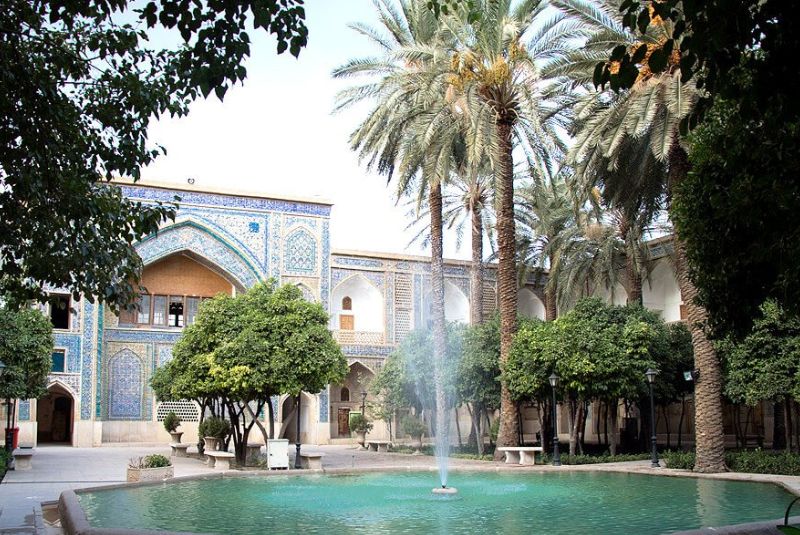
The Khan School, established in 1595 CE (1004 AH) in Shiraz, is a historic educational institution founded by Allahverdi Khan and his son, Imam Qoli Khan, during the reign of Shah Abbas I of the Safavid dynasty.
Allahverdi Khan, originally a Georgian Christian who converted to Islam, created the Khan School as a comprehensive university of its time, where a wide array of subjects, including philosophy, jurisprudence, literature, astronomy, mathematics, geology, zoology, botany, and chemistry, were taught.
One of the most renowned scholars associated with the Khan School was Mulla Sadra, a pivotal figure in Persian philosophy who established the philosophy of "Transcendent Theosophy" (Hikmat-e Mota'aliyah).
Mulla Sadra, who had been exiled from Isfahan, was invited by Allahverdi Khan to Shiraz, where he found refuge to continue his work. Allahverdi Khan's open-mindedness and commitment to intellectual freedom led him to write to Mulla Sadra, offering to build a school in Shiraz specifically for him to teach.
Before the construction was fully completed, Mulla Sadra was already invited to begin his teachings, highlighting the urgency and importance that Allahverdi Khan placed on this endeavor.
Under Mulla Sadra's guidance, the Khan School became one of Iran's leading centers of learning, especially in the fields of philosophy and science. The school's prestige was such that, unlike some other institutions of the time, it required the teaching of rational sciences as a condition for its educators, setting it apart as a beacon of knowledge and intellectual pursuit in Iran.
Khan School History

The Khan School in Shiraz, a historic institution founded in 1595 CE (1004 AH), was the brainchild of Allahverdi Khan, the Georgian governor of Shiraz, who served under Shah Abbas I of the Safavid dynasty.
Originally a Christian captive from Georgia, Allahverdi Khan rose to prominence in the Safavid court, eventually converting to Islam and becoming a powerful military leader and governor of Fars Province.
His vision for the Khan School was to establish a comprehensive educational institution that would teach not only religious subjects like philosophy and jurisprudence but also a wide range of sciences, including astronomy, mathematics, geology, zoology, botany, and chemistry.
The construction of the Khan School was personally financed by Allahverdi Khan, who saw the project as a means to foster intellectual freedom and counter the restrictive atmosphere of his time.
A notable episode in the school’s history is the involvement of Mulla Sadra, a renowned Shiite philosopher and the founder of Transcendent Theosophy (Hikmat-e Mota'aliyah).
Mulla Sadra had been exiled from Isfahan due to his controversial ideas but was invited to Shiraz by Allahverdi Khan, who offered him the Khan School as a place to teach freely.
Before the school’s construction was fully completed, Allahverdi Khan urged Mulla Sadra to begin his teachings, indicating the governor’s eagerness to promote scholarly activities.
Unfortunately, Allahverdi Khan did not live to see the completion of the Khan School. After his death, his son, Imam Qoli Khan, took over the project and ensured the school’s completion in 1615 CE (1024 AH).
The Khan School quickly became a leading center of learning in Iran, attracting scholars and students from across the region. Its emphasis on the teaching of rational sciences set it apart from other institutions of the time, many of which focused solely on religious studies.
Over the centuries, the Khan School has endured several challenges, including damage from a devastating earthquake in 1813 CE (1229 AH). It was subsequently restored by a local Shirazi merchant, Haj Lotfali Shirazi.
Further renovations were carried out in 1852 CE (1269 AH) by Haj Mirza Ali Akbar Qavam al-Molk, and additional repairs were made in the early 20th century by the Fars Province Archaeology Department.
Today, the Khan School remains a significant cultural and historical monument in Shiraz, with ongoing restoration efforts by the Cultural Heritage and Tourism Organization ensuring its preservation for future generations.
Architecture of Khan School in Shiraz
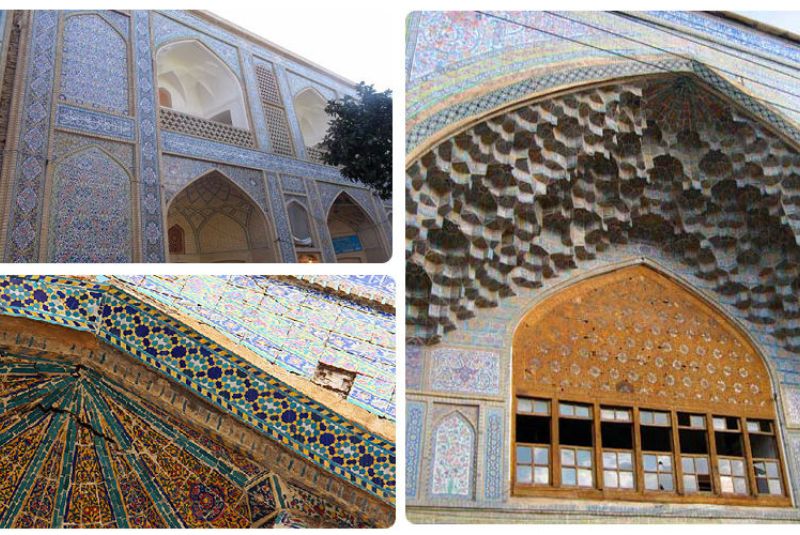
The Khan School in Shiraz is an architectural masterpiece built on a foundation of approximately 7,700 square meters, with the total area of the school being around 5,000 square meters.
This historic institution, constructed during the Safavid era, reflects the grandeur and sophistication of Persian architecture, combining functional design with intricate artistic details.
Layout and Structure
The school originally featured 100 rooms, or hujras, arranged over two floors on all four sides of the courtyard. These rooms were intended for the use of students. Today, only 70 of these rooms remain.
Each hujra is fronted by a small veranda and connected at the back to a corridor. The entry vestibule (hashti) of the school is designed as an octagonal space, adorned with brick latticework.
The ceiling of the hashti is covered with exquisite moqarnas (stalactite) tilework and geometric patterns, similar to those seen in the Nasir al-Mulk Mosque.
Entrance and Decorations
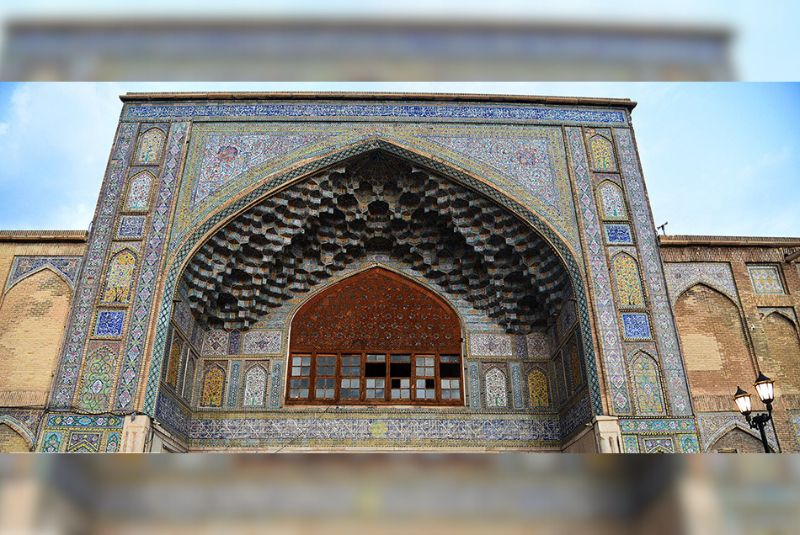
The entrance archway of the school is a significant feature, covered with colorful tiles decorated with floral and arabesque patterns. Below the arch, the walls are adorned with intricate mosaic tiles that display scenes of flowers, trees, birds, and calligraphy.
Two inscriptions featuring Quranic verses in thuluth script are placed prominently above the entrance. These tiles and inscriptions not only serve decorative purposes but also convey the spiritual essence of the school.
Central Courtyard and Water Features
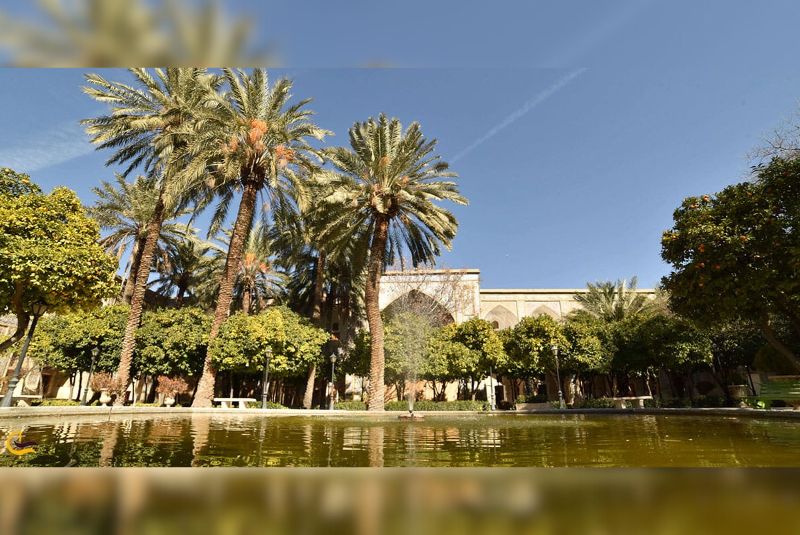
The heart of the Khan School is its central courtyard, which features an octagonal pool surrounded by six gardens planted with palm and orange trees. These gardens were initially designed to provide a serene environment for students to relax and reflect.
The eastern iwan (porch) of the school, which was reconstructed after being damaged, now includes an entrance door and ten windows that open out to the surrounding gardens.
Tilework and Ornamentation
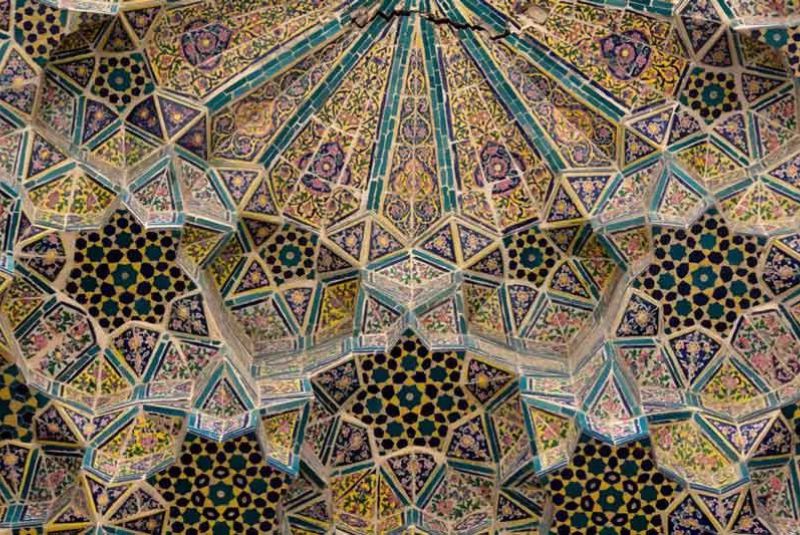
The Khan School is renowned for its exceptional tilework, particularly in the vault behind the hashti, which is considered one of the most magnificent parts of the school.
The vault, adorned with seven-color tiles, showcases elaborate arabesque patterns and floral designs that are both visually stunning and emblematic of Persian artistry.
Quranic verses inscribed in thuluth script are found throughout the school, especially in the arches and columns, adding a spiritual dimension to the architectural beauty.
Sacred Numbers in Architecture
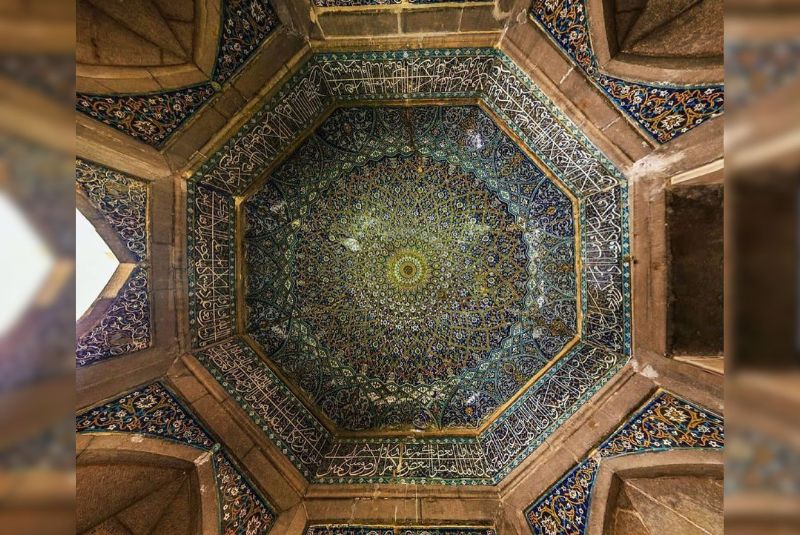
An intriguing aspect of the Khan School’s design is the deliberate use of sacred numbers in its architecture. The school has five teaching spaces, which symbolize the Panjetan (the five holy figures in Islam).
Additionally, there are 14 rooms associated with the teaching spaces, representing the 14 infallibles (Masoumin) in Shia Islam. Scholars believe that the use of these numbers was intentional, reflecting the religious significance embedded in the school’s design.
Restoration and Legacy
Over the centuries, the Khan School has undergone multiple restorations due to damage from earthquakes and the natural wear of time. Notable restorations were carried out by various benefactors, including Haj Lotfali Shirazi in the early 19th century and Haj Mirza Ali Akbar Qavam al-Molk in 1852 CE (1269 AH).
Despite these challenges, the school has retained its historical and cultural significance. The continued efforts by the Cultural Heritage and Tourism Organization and the Housing and Urban Development Organization of Fars Province ensure that this architectural gem remains a testament to the rich history and artistic legacy of Shiraz.
Khan School Location and Access
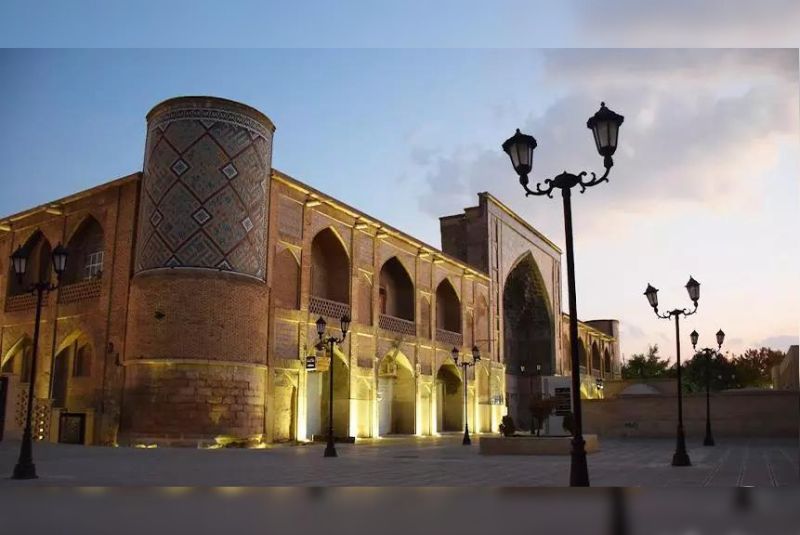
Khan School is one of the notable historical sites in Shiraz, located in the Es'haq Beyg neighborhood. Specifically, it is situated on Lotf Ali Khan Zand Street, just past the Ahmadieh Three-Way Intersection on the left side.
How to Get There
Visitors can reach the school by personal vehicle or public transportation.
Public Transport
The closest metro station is Vali Asr, approximately two kilometers away. If using the bus, you can take the Vali Asr terminal line and alight at either Vali Asr or Ahmadieh stations, continuing the remaining distance on foot.
Personal Vehicle
For those driving, head towards the Vali Asr intersection under the cable bridge, which connects Zeinabiyeh Street to Lotf Ali Khan Zand and Ghadir streets. From this intersection, the school is just 100 meters away.
Alternatively, you can access the location by crossing the Namazi overpass and Ahmadieh Three-Way Intersection. Keep in mind that Lotf Ali Khan Zand Street is a busy thoroughfare in Shiraz, often experiencing heavy traffic.
Best Time to Visit Khan School in Shiraz
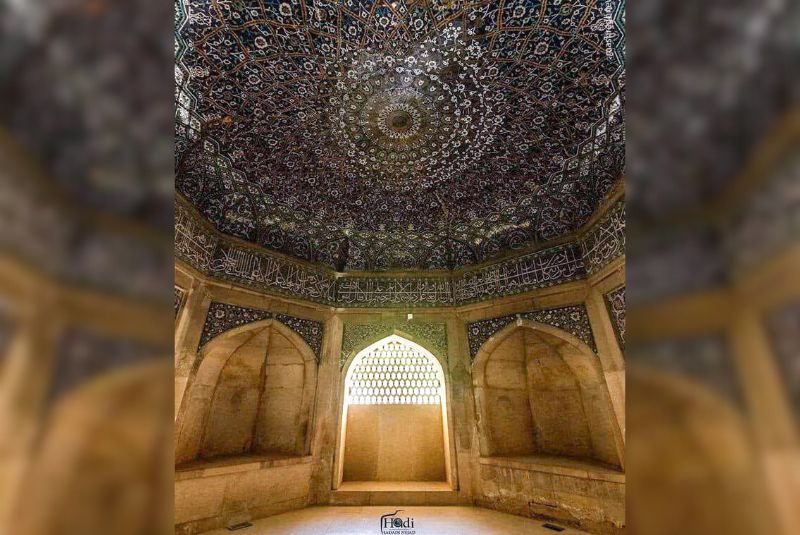
Shiraz is a city you can visit year-round, but the best times to explore the Khan School are in late April and early November. During these months, the city is vibrant with the scent of orange blossoms and the traditional process of distilling their essence.
This period also sees an influx of tourists enjoying the pleasant weather. Additionally, Shiraz experiences its highest tourist numbers during the Persian New Year (Nowruz) holidays in late March.
Opening Hours
Khan School in Shiraz is open for visits from 7:00 AM to 1:30 PM and from 2:30 PM to 6:30 PM. The site is closed on specific religious observances, including Arbaeen, Tasua, Ashura, the martyrdom of Imam Ali, the passing of the Prophet Muhammad (PBUH), the demise of Imam Khomeini, and the martyrdom of Imam Jafar Sadiq.
Ticket Price
The ticket price for visiting Khan School in Shiraz is 3,000 IRR.
Tourist Attractions Nearby
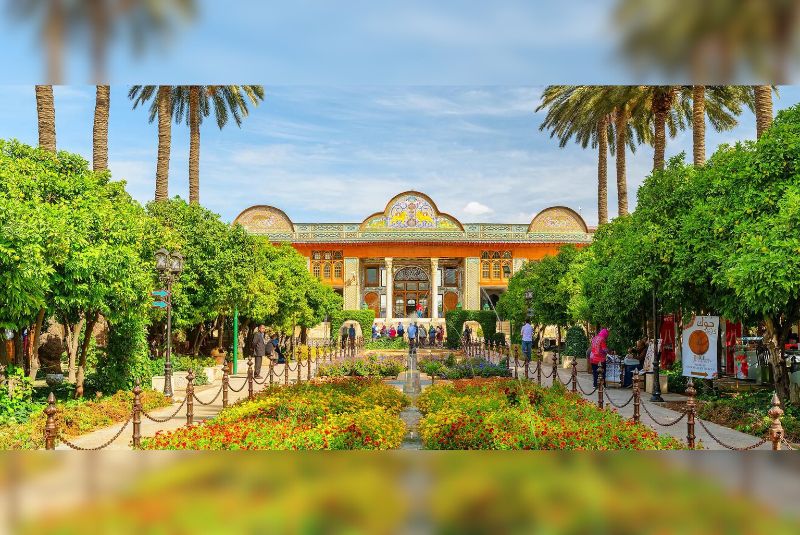
Nearby Madrese Khan in Shiraz, visitors can explore several notable attractions including;
- The Nasir al-Mulk Mosque, famous for its stunning stained glass windows, is just 650 meters away.
- The Qavam House (Naranjestan), renowned for its beautiful gardens, is 1.1 kilometers from the school.
- The Zinat al-Molk House and the Traditional House of Manteq Nejad are both 1.2 kilometers away.
- The Shah Cheragh Mosque, an important pilgrimage site, is located 1.4 kilometers from Khan School.
Hotels Near Khan School
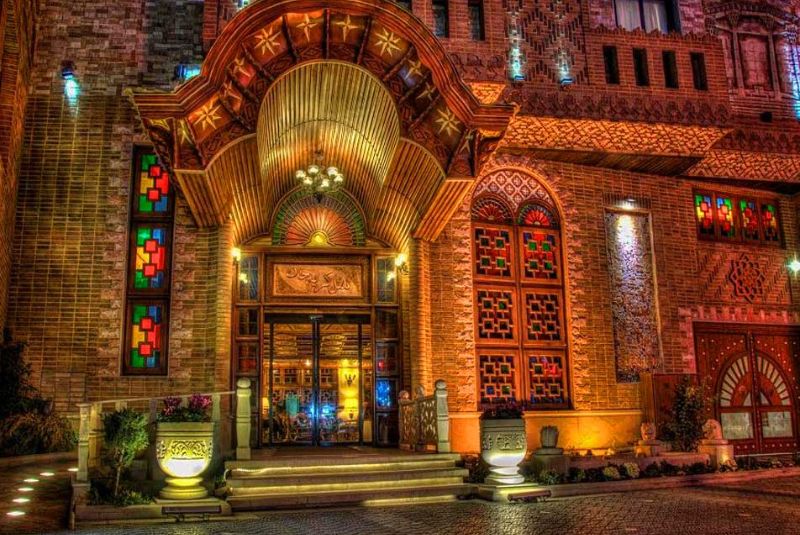
- Golsan Traditional Hotel: 400 meters away, this traditional hotel offers an authentic Shirazi experience with its classic architecture and local hospitality.
- Naranjestan Hotel: Located 500 meters from Khan School, this hotel features elegant rooms and proximity to key attractions.
- Parhami Traditional House: Also 500 meters away, this charming guesthouse provides a cozy and culturally immersive stay.
- Loom Gardi Eco-Lodge: Situated 1.1 kilometers from the school, this eco-friendly accommodation offers a unique and sustainable lodging experience.
- Anna Eco-Lodge: Located 1 kilometer away, Anna Eco-Lodge combines comfort with an environmentally conscious approach.
- Lutfali Khan Hotel: Just 1 kilometer from Khan School, this hotel is known for its convenient location and welcoming atmosphere.
- Seven Colors Mansion: At 1.9 kilometers, this hotel offers a distinctive and colorful stay, reflecting local architectural styles.
Restaurants Near Khan School

- Royal Banu Café-Restaurant: 550 meters away, this venue offers a blend of traditional and contemporary dishes in a royal setting.
- Vakil Traditional Restaurant: Located 650 meters from the school, this restaurant is renowned for its historical ambiance and classic Persian cuisine.
- Saray Mehr Traditional Restaurant: 700 meters away, Saray Mehr offers a range of traditional Persian dishes in a charming setting.
- Sarv Naz Traditional Restaurant: Situated 800 meters from Khan School, this eatery provides an authentic dining experience with a focus on Persian flavors.
- Kateh Mas Restaurant:1 kilometers away, Kateh Mas is known for its delicious Persian rice dishes and warm atmosphere.
Bottom Line
Khan School in Shiraz, established in 1595 CE, stands as a historic educational and architectural marvel. Founded by Allahverdi Khan during the Safavid era, this institution once hosted the famed philosopher Mulla Sadra.
The school features stunning Persian architecture with intricate tilework, symbolic design, and a serene courtyard. Despite its age, it continues to serve as a center of learning and a testament to Shiraz's rich cultural heritage.
Share your story!
Comment below and let us know about your Experience.
Your story inspires others!


Comment
Leave a Comment